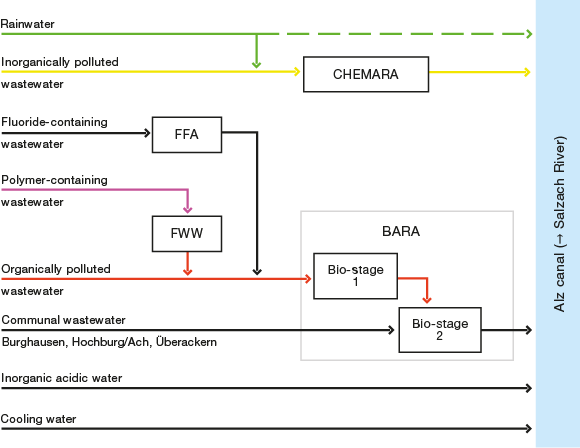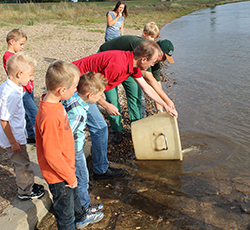Water
Water is an extremely precious resource – not only as drinking water, but also as a raw material, solvent and coolant in many technical and chemical processes. At WACKER, we use water sparingly and protect natural water resources. We always purify our wastewater as effectively as possible and recycle the water through loops in our production. We make sure that this multiple use does not increase energy consumption or otherwise negatively impact the environment.
In many parts of the world, clean water is particularly scarce; obtaining and purifying water is very expensive there. As a globally-active company, we take such conditions into account in our production processes and during transport.
Water Consumption Tested Using the Global Water Tool©
We used the Global Water Tool© (GWT) developed by the World Business Council for Sustainable Development (WBCSD) to analyze the annual relative water stress index of the countries in which our main global production sites are located. These regions represented more than 90 percent of our production volume and around 98 percent of our global water consumption in the 2011 and 2012 reporting years. In the course of our analysis, we also considered the development of the annual renewable water supply until 2025.
The water stress index used, which was defined by the Water Systems Analysis Group of the University of New Hampshire, USA, provides information on the relationship between water consumption and the availability of renewable fresh water. The outcome of the analysis is that our most important production sites are located in regions with a low relative water stress index. More than 97 percent of our annual water consumption occurs in these regions. Production sites in countries for which no water stress index information is available from the GWT account for less than 0.5 percent of our water consumption.
The following diagram depicts how we treat wastewater at our Burghausen site.
Structure of Wastewater Disposal at the Burghausen Site

The colors given for the separate sewers in the schematic correspond to the actual color labeling of the manhole covers at the Burghausen site.
Black denotes a closed pipe route.
Abbreviations (German)
BARA: Biological wastewater treatment plant
CHEMARA: Chemical-mechanical wastewater treatment plant
FFA: Fluoride precipitation plant
FWW: Flocculation, west plant
The process water used at Nünchritz comes from on-site wells (2011: 3,216,008 m3; 2012: 4,056,342 m3). Drinking water accounts for less than 1 percent of our total water consumption at this site. In the course of setting up the polysilicon facilities at our Nünchritz site – which came on stream in 2011 – we expanded the wastewater treatment plants as well. In spring 2011, additional chemical-mechanical cleaning stages were incorporated into the water treatment system, which doubled the capacity for inorganic wastewater.
The town of Freiberg is connected to a highly branched, man-made water ditch system. Our Siltronic site there uses surface water, which is carried to the site by such a ditch, to cool the crystal pulling facilities. We also purify the surface water into hyperpure water for wafer production.
By modifying production processes and re-using materials, our Siltronic division has reduced its use of chemicals, for example in wafer cleaning tanks. As a result, nitrate loads in the wastewater at Siltronic’s sites have fallen by about 70 percent over the last 15 years. We reuse water several times over, wherever the purity requirements for wafer manufacturing permit. This has allowed us to reduce consumption of demineralized (deionized) water by 20 percent in Burghausen and around 30 percent in Portland over the last 15 years without compromising on quality. We monitor the use of ultrapure water in wafer production, where Siltronic achieves a water-recycling rate of up to 45 percent.
At our site in Nanjing, China, we optimized production processes for VAE (vinyl acetate-ethylene copolymer) dispersions, reducing wastewater volumes in 2012 by 11 percent compared to 2010. VAE dispersions are used in the manufacture of adhesives and coatings, for example.
During the period under review, cooling water consumption fell in line with a reduction in capacity utilization at several sites due to the economic downturn. In the case of wastewater, chemical oxygen demand (COD) and adsorbable organic halides (AOX) were both down because we closed the Burghausen acetaldehyde plant in the third quarter of 2012.
| Download XLS |
|
Water Consumption / Emissions to Water | ||||||||||||
|
|
|
|
| |||||||||
|
|
20121 |
20111 |
20102 | |||||||||
| ||||||||||||
|
|
|
|
| |||||||||
|
Water consumption (m3) |
242,072,000 |
268,657,000 |
252,151,000 | |||||||||
|
Cooling water volume (m3) |
225,391,000 |
248,064,000 |
233,153,000 | |||||||||
|
Wastewater volume3 (m3) |
19,569,740 |
21,244,280 |
21,031,000 | |||||||||
|
COD (chemical oxygen demand) (t) |
1,460 |
1,680 |
1,820 | |||||||||
|
AOX (adsorbable organic halides) (t) |
3 |
5 |
6 | |||||||||
|
Heavy metals (t) |
1.2 |
0.8 |
1.3 | |||||||||
|
Nitrogen (t) |
410 |
440 |
420 | |||||||||
|
Phosphorus (t) |
7.0 |
6.8 |
7.0 | |||||||||
WACKER Promotes Diversity of Species in Elbe River

Children look on as WACKER site manager Gerd Kunkel and fisheries inspector Lutz Otto (wearing cap) release new pike into the Elbe River in September 2012.
Stocks of pike in the Elbe River have been dwindling over recent years. This can be attributed above all to long periods of low water levels. WACKER has taken an active role here in supporting biodiversity. In September 2012, Nünchritz site manager Gerd Kunkel released locally farmed pike into the Elbe. Experts at the sport-fishing association expect this measure to increase the size of the river’s pike population. Mature pike serve as “health police,” eating animals that are ill, weak or injured and thus keep the water clean.
According to fisheries inspector Lutz Otto, water discharged from the WACKER wastewater treatment plant in Nünchritz is clean and popular with predatory and other fish, which easily find food in the clear and relatively warm water. The wastewater is monitored at the plant by WACKER, in a dedicated lab. Here flow rate, temperature, pH values and further chemical parameters are continually measured. In addition, the authorities test the quality of the water through taking unannounced random samples.